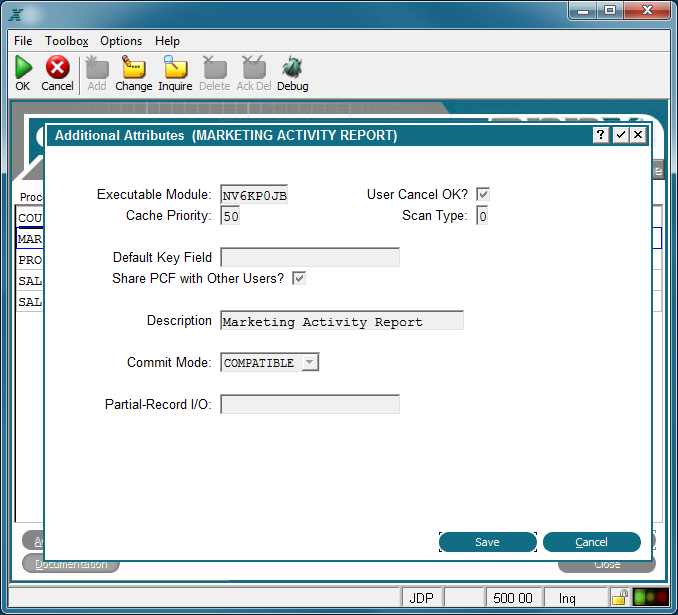Chapter 3-9: Query Processes |
Query Process Additional Attributes Option Additional Attributes accesses the query process Additional Attributes overlay from which you can alter the standard EM attributes.
Query Process Additional Attributes Overlay The query Additional Attributes overlay shown above contains the following fields: Executable Module displays the name of the executable module (EM) that is automatically generated by APPX. APPX derives the file name from the date and time the currently selected query process was added. The name consists of a unique string of eight alphanumeric characters and cannot be changed. If APPX finds it necessary to recreate the EM, the new EM retains the same file name. This field is common to the Additional Attributes overlay for all types of processes.
User Cancel OK? contains either 'yes' Cache Priority establishes the likelihood that the process will remain in memory after execution, relative to other processes that the user has also completed executing. A process with a cache priority of 99 is most likely to remain in memory. A process with a cache priority of 1 is least likely to remain in memory. A cache priority of 0 indicates that the process is never cached. The default is 1. This field is common to the Additional Attributes overlay for all types of processes. Scan Type governs whether or not the application user is permitted to scan and further constrain the individual records in the query?s generated pointer file.The Scan Type options are0 Do Not Scan which prohibits the user from scanning and individually constraining records and 1 Scan which permits the user to scan and constrain records. The default is 0 Do Not Scan. Default Key Field designates the specific keypath that is initially presented to a user invoking this process. If blank, the primary key is used. This specification is overridden by the default keypath that is defined for the child process invocation of the process. Share PCF with Other Users? indicates whether the designated PCF file is available to other users while this process is executing. Description is incorporated in the message that displays on the screen when the query process is compiling. It is used to communicate with users since it provides a more descriptive and easily understood alternative to Process Name, which is the default if this field is left blank. The Additional Attributes overlay for all types of processes contain this field. Commit Mode controls the commit mode for a process and can be selected from a drop-down list of available options. Commit Mode determines those points in time when APPX will commit changes made to the tables stored within an RDBMS. It is only applicable in conjunction with an RDBMS; it has no effect with APPXIO. Also, not all File Managers support this feature. Although initially set here for the process, it can be added or overridden by use of predefined field COMMIT MODE. The following options are available: COMPATIBLE. Changes are committed as soon as all locks are freed. This provides maximum compatibility between APPXIO files and RDBMS tables.
AUTOCOMMIT*. APPX will commit each modification as it is made. PCF CYCLE. APPX will commit modifications as each PCF record is processed. END. APPX will only commit modifications at the end of the process family. MANUAL. APPX will not automatically commit changes. You must use the COMMIT statement to do so. Partial-Record I/O is used to specify a field from the PCF file so that instead of operating on the entire PCF record, APPX operates on the designated field only. If the field is a group header, then I/O will be performed on all members of the group. Utilizing partial-record I/O can greatly improve performance when the PCF is a table in an RDBMS. This is especially true when the table contains many columns, but relatively few are being utilized by the process. The scan option is available for field selection. See the Establish PCF Range section in Using Event Points for a discussion about the use of Beg At/End At statements to further constrain records in a query process. |
Application Design Manual "Powered by Appx Software"1100 ©2006 By APPX Software, Inc. All Rights Reserved |
